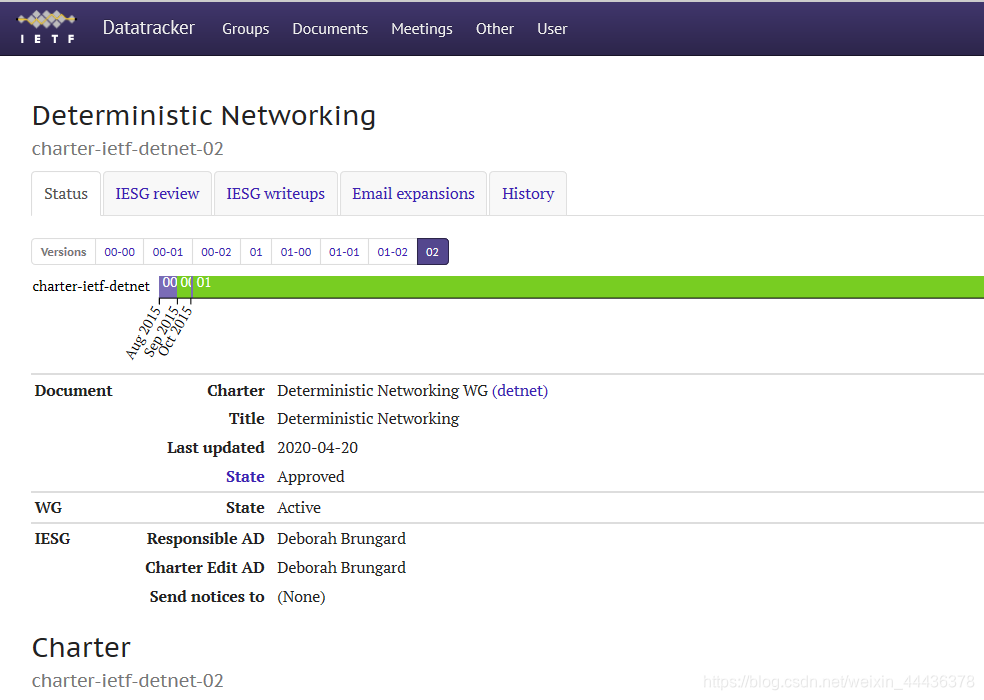一、DetNet工作组介绍
1.1 工作组章程
DetNet工作组英文全称是Deterministic Networking WG (detnet),官方文档在https://datatracker.ietf.org/wg/detnet/about/中可见。
简单概括一下Chater的内容:
主要工作:工作组关注第3层网络,与负责第2层网络的IEEE802.1 TSN合作定义了共同的体系结构,提供有边界保障的延迟、丢失和抖动以及高可靠性。
适用应用:包括专业和家庭音频/视频,交通多媒体,发动机控制系统,和IEEE 802.1 TSN任务组正在考虑的其他通用工业和车辆应用。
网络范围:在单一行政管制下或在封闭的行政管制组内的网络,如校园网络,私人wan。
标准内容:
(1) 总体架构:该工作包括数据平面、OAM、时间同步、管理、控制和安全方面。
(2) 数据平面:这项工作将记录如何使用IP和/或MPLS,以及相关的OAM,以支持流识别的数据平面方法和第三层上的数据包转发。
(3) 控制面: “控制面和管理面的集合”,这项工作将记录如何使用IETF控制平面解决方案来支持DetNet。
(4) 数据流信息模型:这项工作将确定流建立和控制所需的信息,并被保留协议和YANG数据模型所使用。
(5) YANG models:这项工作将记录设备和链接能力(特性支持)和资源(例如缓冲区、带宽),以便在设备配置和状态报告中使用。
Charter原文如下,(注:可用名词加粗,不太理解的斜体)
The Deterministic Networking (DetNet) Working Group focuses on deterministic data paths that operate over Layer 2 bridged and Layer 3 routed segments, where such paths can provide bounds on latency, loss, and packet delay variation (jitter), and high reliability. The Working Group addresses Layer 3 aspects in support of applications requiring deterministic networking. The Working Group collaborates with IEEE802.1 Time-Sensitive Networking (TSN), which is responsible for Layer 2 operations, to define a common architecture for both Layer 2 and Layer 3. Example applications for deterministic networks include professional and home audio/video, multimedia in transportation, engine control systems, and other general industrial and vehicular applications being considered by the IEEE 802.1 TSN Task Group. The Working Group will initially focus on solutions for networks that are under a single administrative control or within a closed group of administrative control; these include not only campus-wide networks but also can include private WANs. The DetNet WG will not spend energy on solutions for large groups of domains such as the Internet. The Working Group is responsible for the overall DetNet architecture and DetNet-specific specifications that encompasses the data plane, OAM (Operations, Administration, and Maintenance), time synchronization, management, control, and security aspects which are required to enable a multi-hop path, and forwarding along the path, with the deterministic properties of controlled latency, low packet loss, low packet delay variation, and high reliability. The work applies to point-to-point (unicast) and point-to-multipoint (multicast) flows which can be characterized in a manner that allows the network to 1) reserve the appropriate resources for the flows in advance, and 2) release/reuse the resources when they are no longer required. The work covers the characterization of flows, the encapsulation of frames, the required forwarding behaviors, as well as the state that may need to be established in intermediate nodes. Layer 3 data plane technologies that can be used include: IP and MPLS, and Layer 2 encapsulations that run over IP and/or MPLS, such as pseudowires and GRE. The Working Group will document which deployment environments and types of topologies are within (or outside) the scope of the DetNet architecture. This work focuses on the data plane aspects and is independent from any path setup protocol or mechanism. The Working Group will also document DetNet Controller Plane approaches that reuse existing IETF solutions, such as Path Computation Element (PCE), and identify the Working Group responsible for any extensions needed to support DetNet. Documents produced by the Working Group will be compatible with the work done in IEEE802.1 TSN and other IETF Working Groups. The Working Group’s scope explicitly excludes modifications of transport protocols, OAM, Layer 3 forwarding, and encapsulations, but it may discuss requirements for such modifications and the work will be done in the Working Group responsible for the technology. DetNet is chartered to work in the following areas: Overall architecture: This work encompasses the data plane, OAM, time synchronization, management, control, and security aspects. Data plane: This work will document how to use IP and/or MPLS, and related OAM, to support a data plane method of flow identification and packet forwarding over Layer 3. Other IETF defined data plane technologies may also be used. Controller Plane: The DetNet Controller Plane is defined in RFC 8655 as “the aggregation of the Control and Management Planes”. This work will document how to use IETF control plane solutions to support DetNet, including the identification of any gaps in existing solutions. Any modification to Controller Plane protocols to address identified gaps should be carried out in their associated Working Groups, but may be done in DetNet if agreed to by the relevant Working Group chairs and responsible Area Directors. Data flow information model: This work will identify the information needed for flow establishment and control and be used by reservation protocols and YANG data models. The work will be independent from the protocol(s) used to control the flows (e.g. YANG+NETCONF/RESTCONF, PCEP or GMPLS). YANG models: This work will document device and link capabilities (feature support) and resources (e.g. buffers, bandwidth) for use in device configuration and status reporting. Such information may also be used when advertising the deterministic network elements to a control plane. Control plane related information will be independent from the protocol(s) which may be used to advertise this information (e.g. IS-IS or GMPLS extensions). Any new YANG models will be coordinated with the Working Groups that define any base models that are to be augmented. As needed,vertical requirements: This effort will detail the requirements for deterministic networks in various industries that have previously not been documented and cannot be supported using defined DetNet solutions. To investigate whether existing data plane encryption mechanisms can be applied, possibly opportunistically, to improve security and privacy. The Working Group coordinates with other relevant IETF Working Groups, including CCAMP, IPPM, LSR, PCE, PALS, TEAS, TSVWG, RAW, and 6TiSCH. As the work progresses, requirements may be provided to the responsible Working Group, e.g. PCE, TEAS,and CCAMP, with DetNet acting as a focal point to maintain the consistency of the overall architecture and related solutions. The WG will liaise with appropriate groups in IEEE and other Standards Development Organizations (SDOs).
原文翻译如下:
确定性网络(DetNet)工作组主要关注在第2层桥接和第3层路由段上运行的确定性数据路径,在这些路径中,这些路径可以
提供延迟、丢失和包延迟变化(抖动)以及高可靠性的边界。
工作组处理层3方面,以支持需要确定性网络的应用程序。
工作组与负责第2层操作的IEEE802.1时敏网络(TSN)合作,为第2层和第3层定义了共同的体系结构。
确定性网络的例子应用包括专业和家庭音频/视频,交通多媒体,发动机控制系统,和IEEE 802.1 TSN任务组正在考虑的其他通用工业和车辆应用。
工作组最初将集中解决在单一行政管制下或在封闭的行政管制组内的网络;
这些不仅包括校园网络,还可以包括私人wan。
DetNet工作组不会把精力花在解决Internet等大型领域的解决方案上。
工作小组负责整个DetNet架构和DetNet-specific规范,包括数据平面,OAM(操作、管理和维护),时间同步,管理,控制,和安全方面需要启用一种路径,
沿着路径和转发,与确定性的属性控制延迟、低丢包、低分组延迟变异,可靠性高。
这项工作适用于点对点(单播)和点对多点(多播)流,它的特征是允许网络1)预先为流预留适当的资源,2)释放/重用不再需要的资源。
工作涵盖了流的特性,帧的封装,所需的转发行为,以及中间节点可能需要建立的状态。
可以使用的第三层数据平面技术包括:IP和MPLS,和运行在IP和/或MPLS上的第二层封装,如pseudowires和GRE。
工作组将记录哪些部署环境和拓扑类型在DetNet体系结构的范围之内(或之外)。
这项工作集中在数据平面方面,独立于任何路径设置协议或机制。
工作组还将记录重用现有IETF解决方案(如路径计算元素(PCE))的DetNet控制器平面方法,并确定负责支持DetNet所需的任何扩展的工作组。
工作组编制的文件将与IEEE802.1 TSN和其他IETF工作组的工作兼容。
工作组的范围明确排除了对传输协议、OAM、第三层转发和封装的修改,但可以讨论这些修改的要求,工作将在负责该技术的工作组中完成。
DetNet被授权从事以下领域的工作:总体架构:该工作包括数据平面、OAM、时间同步、管理、控制和安全方面。
数据平面:这项工作将记录如何使用IP和/或MPLS,以及相关的OAM,以支持流识别的数据平面方法和第三层上的数据包转发。
还可以使用其他IETF定义的数据平面技术。
控制面:DetNet控制面在RFC 8655中定义为“控制面和管理面的集合”。
这项工作将记录如何使用IETF控制平面解决方案来支持DetNet,包括识别现有解决方案中的任何缺陷。
任何对管制飞机协议的修改,以解决确定的差距,应在其相关的工作小组进行,但如果相关工作小组主席和负责区域主任同意,可在DetNet进行。
数据流信息模型:这项工作将确定流建立和控制所需的信息,并被保留协议和YANG数据模型所使用。
工作将独立于用于控制流的协议(如YANG+NETCONF/RESTCONF、PCEP或GMPLS)。
YANG models:这项工作将记录设备和链接能力(特性支持)和资源(例如缓冲区、带宽),以便在设备配置和状态报告中使用。
当将确定性网络元素投放到控制平面时,也可以使用这些信息。
控制平面相关信息将独立于用于发布这些信息的协议(例如IS-IS或GMPLS扩展)。
任何新的YANG模型都将与定义任何要扩展的基础模型的工作组进行协调。
根据需要,垂直需求:此工作将详细说明各种行业中的确定性网络的需求,这些网络以前没有文档记录,并且不能使用已定义的DetNet解决方案进行支持。
调查现有的数据平面加密机制是否可以应用(可能是偶然地),以提高安全性和私密性。
工作组与其他相关的IETF工作组进行协调,包括CCAMP、IPPM、LSR、PCE、PALS、tea、TSVWG、RAW和6TiSCH。
随着工作的进展,需求可能会被提供给负责的工作组,例如PCE、tea和CCAMP, DetNet作为一个焦点来维持整体架构和相关解决方案的一致性。
工作小组将与IEEE和其他标准开发组织(SDOs)中适当的小组联系。1.2 工作组里程碑
用例-架构-YANG模型-问题-数据面-OAM-安全-流信息模型-控制面-YANG模型-TSN数据面-IP OAM-控制面-IP控制面
二、DetNet技术文档
可以在这个网址看到所有的文档
个人更推荐这个界面,感觉简洁一些

简要说明后部分标准的内容,详细以后填坑:
- draft-du-detnet-layer3-low-latency-00:一种降低三层网络中低延迟流量微突发的方法。
https://tools.ietf.org/id/draft-du-detnet-layer3-low-latency-00.txt - draft-geng-detnet-dp-sol-srv6-02:此文档为SRv6封装的用户数据指定了确定性网络数据平面操作。
https://tools.ietf.org/id/draft-geng-detnet-dp-sol-srv6-02.txt - draft-malis-detnet-controller-plane-framework-04:本文档提供了确定性网络(DetNet)控制器平面的框架概述。它讨论将作为Detnet控制器平面解决方案文档基础的概念和需求。
https://tools.ietf.org/id/draft-malis-detnet-controller-plane-framework-04.txt - draft-mirsky-detnet-ip-oam-02:本文档定义了在具有IP数据平面的确定性网络中使用操作、管理和维护协议和机制的原则。
https://tools.ietf.org/id/draft-mirsky-detnet-ip-oam-02.txt - draft-mirsky-detnet-mpls-oam-01:本文档定义了在具有IP数据平面的确定性网络中使用操作、管理和维护协议和机制的原则。本文档列出了确定性网络(DetNet)中操作、管理和维护(OAM)工具集的功能需求,并使用这些需求;定义在DetNet网络上与MPLS数据平面相关联的通道的格式和使用DetNet服务的主体。
https://tools.ietf.org/id/draft-mirsky-detnet-mpls-oam-01.txt - draft-xiong-detnet-qos-policy-02:本文档提出了一个服务质量(QoS)策略来应用确定性网络(DetNet)的差异化服务(DiffServ)模型,并定义了一个DetNet差异化服务机制,包括DetNet IP和MPLS封装。
- draft-ietf-detnet-topology-yang-00:本文档定义了用于确定性网络(DetNet)拓扑发现和能力配置的YANG数据模型。本文档中定义的YANG模块符合网络管理数据存储体系结构(NMDA)。